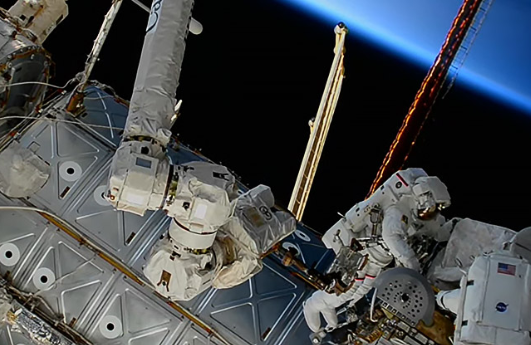
NASA astronaut Steve Bowen and UAE astronaut Sultan Alneyadi conclude their spacewalk.
HOUSTON—Two astronauts from NASA and the United Arab Emirates (UAE) conducted a 7-hr., 1-min. spacewalk on April 28 to prepare the starboard end of the International Space Station’s (ISS) long solar power truss for upcoming installations of a third pair of roll out solar arrays (iROSAs).
Sultan Alneyadi’s spacewalk was the first by a UAE astronaut and an Arab. After training with NASA for a six-month mission to the seven-person orbital science laboratory, he launched aboard the SpaceX Crew-6 Dragon mission to the ISS in early March with his spacewalk partner, Steve Bowen of NASA, as well as NASA astronaut Woody Hoburg and Russian cosmonaut Andrey Fedyaev.
“Sultan, you are making history. Congratulations,” said Hoburg, who helped his two colleagues suit up and prepare for their excursion.
“It’s a great moment for the UAE,” Alneyadi said as the spacewalk came to a close.
After exiting the ISS U.S. segment Quest airlock at 9:11 a.m. EDT, Bowen and Alneyada made their way along the near 360-ft.-long solar power truss to the starboard 1B and 1A power channel sites. While there, they installed power cables at the 1B work site and secured multilayer insulation to mast support structures installed during previous spacewalks at both the 1B and 1A sites upon which the two iROSAs are to be mounted.
NASA is looking to early June for the launch of the agency’s 28th SpaceX Dragon resupply mission from Kennedy Space Center to deliver the fifth and sixth iROSAs planned for installation at the two starboard power channels. The agency is looking to complete the spacewalk iROSA installations by the end of June if the scheduling of other high-priority ISS activities permits, Dina Contella, NASA ISS program operations integration manager, told an April 24 news briefing.
The work is to complete an upgrade to the orbital lab’s initial eight sets of solar panels, which were launched and installed by space shuttle crews between December 2000 and March 2009.
The first pairs of the six iROSAs included in the overall upgrade were installed with multiple NASA-led spacewalks in June 2021 and December 2022. In sequence, those include the 2B and 4B power channels on the port end of the solar power truss, the 3A power channel on the starboard end and 4A channel on the port end.
Last year, Congress authorized an extension of ISS operations from 2024 until the end of 2030. The European, Japanese and Canadian space agencies have concurred with that plan. Roscosmos, the Russian space agency, has agreed to an extension through 2028.
The ISS has been continuously staffed since November 2000, and NASA is in the process of preparing the transition of its ISS science and technology activities to commercially developed space station successors as it turns the agency’s human exploration focus to the Moon and Mars.
The initial ISS solar arrays were made with a 15-year design life. Each of the iROSAs adds a 20-kW solar power generation capability for life support and scientific research.
Once the iROSA upgrade is complete, total power generation from the original solar panels and iROSAs is anticipated to be 215 Kw.
With their hand-intensive activities at the IB and IA power channel sites on the truss complete, Bowen and Alneyadi moved on to attempt the retrieval of an aging S-band communications antenna radio frequency group (RFG), the computer control source for a critical high and low gain S-band antenna. The goal was to deliver it to the Quest airlock, where it was to be prepared for return to Earth for refurbishment and returned to the ISS.
However, once eight screw fasteners were removed by Bowen, a jacking bolt could not be unscrewed. Using a pry bar and some jiggling, the spacewalkers managed to break the jacking bolt. But still unable to free the device from its stanchion, Alneyadi was instructed to strike an RFG docking fixture with a rubber hammer. That also failed to free the device.
Bowen then reinstalled the fasteners he had removed earlier to ensure the RFG remains secure pending further attempts to retrieve the device. NASA’s Mission Control noted the RFG was not initially designed for spacewalk interactions.
As part of the nearly 2-hr. work-around attempt, Bowen participated with his feet planted in an adjustable foot restraint secured to the end of the orbital lab’s Canadian robot arm, which was commanded from inside the station by Hoburg to provide the spacewalker with mobility.
The spacewalk began at 9:11 a.m. EDT and concluded at 4:12 p.m. EDT.





